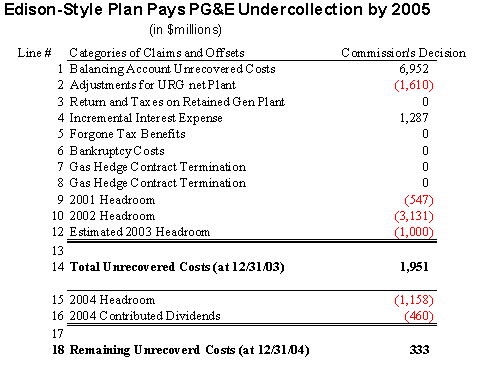VI. The Modified Settlement Agreement (MSA) Will Allow PG&E to Recover its Undercollection and Emerge from Bankruptcy.
The Modified PSA adopts a simple and short-term methodology that utilizes current rates and contribution of PG&E earnings to recover PG&E's undercollection, allowing PG&E to regain financial health in the very near term. The Modified PSA, would maintain the current rates through the end of 2004, and drop rates by approximately 1.6 cents per kilowatt-hour in 2005, which would cost the ratepayer approximately $3.1 billion less than the regulatory asset scheme proposed in the settlement agreement. At its essence, the Modified Settlement Agreement (MSA) adopted today, is similar to the Edison model, and shall commit to maintaining rates at current levels until the undercollection is reduced to zero, or until the first quarter of 2005, whichever is sooner. In addition, it provides for a reduction of the undercollection by any refunds obtained from FERC during the repayment period. As to anticipated rates, the Modified PSA satisfies our concern that the settlement fall within the "reasonable range of outcomes" that would result had the case proceeded to trial. (See, Southern Calif. Edison Co., D.02-06-074.) Finally, it contains PG&E's commitment not to unilaterally attempt to disaggregate.37
There are provisions in both the PSA and the Modified PSA that enhance PG&E's fiscal soundness. These elements are: the ratemaking treatment associated with the use of headroom to recover PG&E's undercollection;38 a Commission commitment not to allow procurement costs to impair collection of other costs; and a Commission commitment not to discriminate against PG&E as compared with other utilities.39 With the undercollection resolved, and the benefit of our experience with the Edison PROACT repayment methodology, we are confidant PG&E will be able to emerge from bankruptcy and continue to provide safe, reliable service.
To find a more equitable resolution of PG&E's financial condition, and to ensure that PG&E recovers its actual undercollections, we shall approve a modified settlement that would adopt a similar mechanism as to the one we used to ensure Edison's investment-grade creditworthiness. In oral arguments on December 2, 2003, CLECA's representative, William Booth stated that the large industrial users CLECA represents would prefer sustaining today's high rates for one more year, rather than prolong the high rates that the Proposed Settlement Agreement would require for nine years.
ORA recommends a mechanism similar Edison-style method to make PG&E whole. (Ex. 139, Chapter 4, ORA/Danforth) ORA proposes that we maintain PG&E's current rates through the end of 2004. At the conclusion of 2004, ORA recommends that if the net undercollection is less than $1 billion, the current rates would remain in effect until the TCBA undercollection is reduced to zero; and if the net undercollection40 should be greater than $1 billion, the remaining amount would be recovered via financing paid for by securitized bonds to be paid for with a Dedicated Rate Component ("DRC").
We shall adopt a modified settlement that utilizes an "Edison-style" methodology, similar to the one proposed by ORA, however, we shall modify ORA's recommendation to simply maintain current rates and require the contributions of PG&E's dividends to pay down accumulated debt until PG&E's undercollection is reduced to zero (referred to hereafter as "the repayment period").
In the discussion above, not including headroom for 2003, we have found PG&E's net undercollections to be $2.95 billion. The proposed settlement agreement settled on 2003 headroom between $775 million and $875 million. It is reasonable to expect that the headroom will in fact total or approach the amounts for headroom expected for 2004, or about $1 billion.41 Based on the information in PG&E's reply briefs42, we expect that current rates would generate approximately $1.15 billion in headroom in 2004. (Ex. 139, p. 4-2, ORA/Danforth) In addition, we shall require PG&E to contribute its available dividends43 over the repayment period. Subtracting the $2.15 billion in headroom from 2003 and 2004 from the $2.95 billion undercollection, and contributing PG&E's dividends for 200444 would allow PG&E to recover its entire undercollection by the first quarter of 2005. These estimates are highly conservative estimates, based largely on PG&E's un-audited information.
A summary table is included below.

We approve a modified settlement that utilizes the above method for recovering PG&E's undercollection because it 1) treats PG&E and Edison similarly, without giving PG&E an economic, legal, and regulatory windfall because of its attempts to circumvent state regulation via the bankruptcy courts, 2) it fairly shares the burden of PG&E's bankruptcy on shareholders and ratepayers, and 3) it will allow rates to be reduced by at least 1.6 cents per kilowatt-hour in the first quarter of 2005, and 4) after our experience with Edison, we know such a method is capable of repaying the utility's debts and ensuring investment-grade creditworthiness.
Moreover, it is free of the considerable legal vulnerabilities discussed in Section V(A) above, which will not close this chapter but will instead spawn additional litigation and unjustifiably higher rates that what would otherwise be just and reasonable.
37 Id. Statement of Intent ¶ 3; Agreement ¶ 11(b). 38 Exhibit 139, Chapter 4. 39 Exhibit 101, 1-9:2-6. See generally Exhibit 101a, ¶ 2(f). 40 ORA's recommended calculation of PG&E's undercollection is "the sum of the balances in the TCBA, as restated pursuant to D.01-03-082, and the Generation Asset Balancing Account ("GABA")." (Ex. 139, p. 4-2, ORA/Danforth) 41 Estimate based on PG&E's quarterly TCBA reports, filed with the CPUC, which track the accumulation of headroom. 42 PG&E reply briefs, p. 3, filed October 20, 2003. 43 Available dividends are earnings less amounts needed to fund capital expenditures. 44 Based on information contained in PG&E's Workpapers, Chapter 5, pp 5, 11 PG&E/Campbell.


